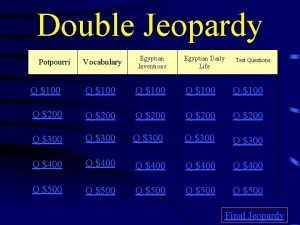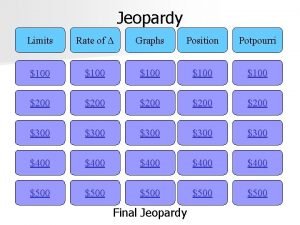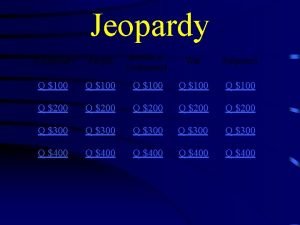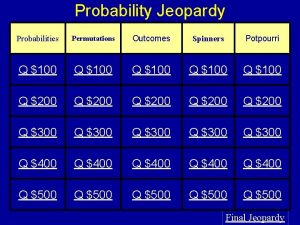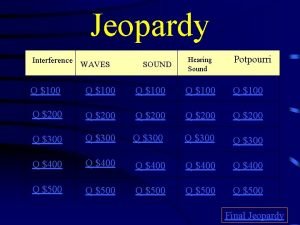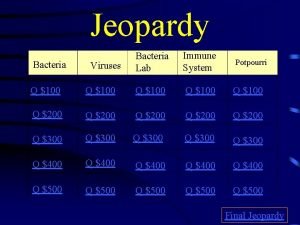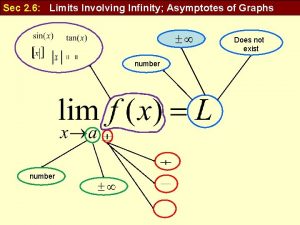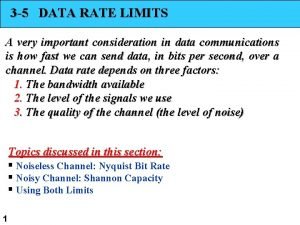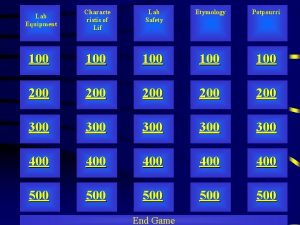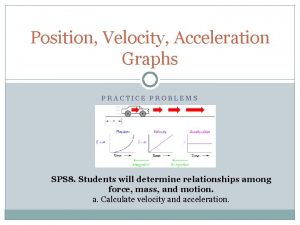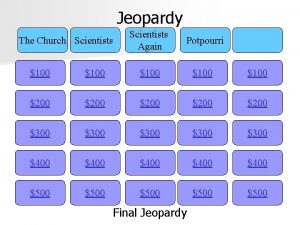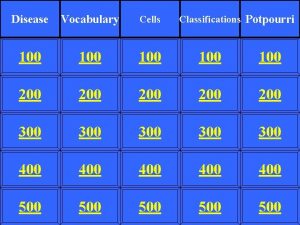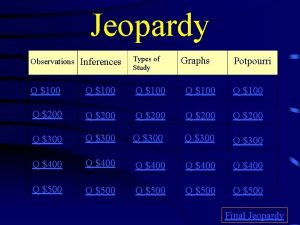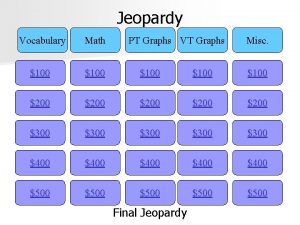Jeopardy Limits Rate of Graphs Position Potpourri 100



























- Slides: 27

Jeopardy Limits Rate of Δ Graphs Position Potpourri $100 $100 $200 $200 $300 $300 $400 $400 $500 $500 Final Jeopardy

Limits - $100 n The limit as x approaches 0 of f(x)=3 x/x by limit def. n What is 3? n This question teaches the basics of defining of a limit as x approaches 0 due to the multiplicative property of association because 3 x/x is equal to 3(x/x) which equals 3.

Limits - $200 n The limit as x approaches 3 of the function f(x) = 5/(x-3) n What is DNE?

Limits - $300 n The limit as x approaches 9 of (1/x – 1/9)/(x-9) n What is -1/81?

Limits - $400 n The limit as h approaches 0 of the function ((1+h)1/2 – 1)/h. n What is 1/2?

Limits - $500 n The limit as x approaches 2 of the function f(x) = (abs(x-2))/(x-2) n What is DNE?

Rate of Δ - $100 n Given point A and point B of a continuous function, with point A at (0, 3) and point B at (7, 14), this quantity represents the average rate of change over the interval from point A to point B n What is 11/7?

Rate of Δ - $200 n Using linear approximation, this quantity represents the value when x=3. 2 of the function f(x)=x 5 n What is 362?

Rate of Δ - $300 n Given point A and point B of a continuous function, with point A at (4, -3) and point B at (6, 0), this integer, representing an x-value, must exist over the function n What is 5?

Rate of Δ - $400 n An open box exists having a square base and surface area of 108 square inches. This quantity represents the dimensions of such box with maximum volume. n What is 6 X 6 X 3?

Rate of Δ - $500 n The desks in Mr. Farrar’s class are arranged in a rectangular figure with all desks equal height. From the front to back of the class, the length of the space occupied by the desks is 30 ft. Every day, the space occupied by the desks widens by 3 ft. When the width of the area is 48 ft, this quantity represents how fast the area is changing. n What is 90 square feet per day?

Graphs - $100 n The second derivative is positive between these intervals n What is (a, b) and (c, d)?

Graphs - $200 n Sketch a graph where f’’(x) is always positive and f’(x) goes from positive to negative @ x=-3 with zeroes at x= -1 and -5

Graphs - $300 n f(x)=|x 2 -9| is not differentiable at these points. n What is (3, 0) (-3, 0)?

Graphs - $400 n These represent the rel. extrema of the function f(x)=x 4 -2 x 2 on the interval [-2, 2] n What is a Rel. min at (1, -1) (-1, -1) and rel. max at (0, 0)?

Graphs - $500 n What is an abs. max at (π/6 , (3/2)31/2) and min at (π/2 , 0)?

Position - $100 n The velocity of a particle moving along the x axis at time t is represented by the function f(t)=5 t 2/3+6 t. This quantity represents the total distance travelled by the particle from t=1 to t=8 seconds. n What is 282 meters?

Position - $200 n The displacement of an object moving in a straight line is given by s(t)=1+2 t+t 2/4. This quantity represents the instantaneous velocity at t=1 second. n What is 2. 5 m/s?

Position - $300 n A bottle rocket shot upward from a 10 ft stand has velocity as represented in the function v(t)=50 -1. 6 t. This quantity represents the time at which the rocket hits maximum height. n What is 31. 25 seconds?

Position - $400 n A particle is positioned along the x-axis as represented by the function f(x)=x 3+8 x 2+9. This quantity represents the particle’s acceleration when velocity is 12 m/s. n What is 20 m/s/s?

Position - $500 n Given the position function of a particle being s(t)=2 t 3 -9 t 2, this duration represents the period at which the particle is speeding up. n What is (0, 3/2) & (3, ∞)?

Potpourri - $100 n The first derivative of f(x)=sin-1(k 48 cos(k)) n What is 0?

Potpourri - $200 n The equation of the horizontal asymptote of the function f(x)=(73 x 2)/√(14 x 5) n What is x=0?

Potpourri - $300 n The function f(x) such that the point (0, 5) exists and 18 x+4 is the first derivative of the function n What is f(x)=9 x 2+4 x+5?

Potpourri - $400 n The fourth derivative of the function f(x)=42 n What is 0?

Potpourri - $500 n 33 n What is 27?

Final Jeopardy n A particle moves along the x-axis, starting at x=0 and stopping at x=5, with an initial velocity of 18 m/s according to this position function. n s(x)=(-5/36)x 2+18 x
 100 100 100 100 100
100 100 100 100 100 Jeopardy potpourri
Jeopardy potpourri Potpourri jeopardy
Potpourri jeopardy Jeopardy potpourri
Jeopardy potpourri Potpourri jeopardy
Potpourri jeopardy Potpourri jeopardy
Potpourri jeopardy Potpourri jeopardy
Potpourri jeopardy Jeopardy potpourri questions
Jeopardy potpourri questions The wooden bowl conflict
The wooden bowl conflict Potpourri jeopardy
Potpourri jeopardy Lab
Lab Potpourri jeopardy
Potpourri jeopardy Potpourri jeopardy questions
Potpourri jeopardy questions Jeopardy text
Jeopardy text Infinite limits and limits at infinity
Infinite limits and limits at infinity Shape 65
Shape 65 First position second position third position
First position second position third position Limits involving infinity asymptotes
Limits involving infinity asymptotes Testability tips in software testing
Testability tips in software testing Comparing distance/time graphs to speed/time graphs
Comparing distance/time graphs to speed/time graphs Graphs that enlighten and graphs that deceive
Graphs that enlighten and graphs that deceive 5-3 polynomial functions
5-3 polynomial functions Data rate limits
Data rate limits Potpourri etymology
Potpourri etymology Distance velocity acceleration graphs
Distance velocity acceleration graphs Position vs time graphs
Position vs time graphs 50 sayısının 20'si kaçtır
50 sayısının 20'si kaçtır 200+200+100+100
200+200+100+100

